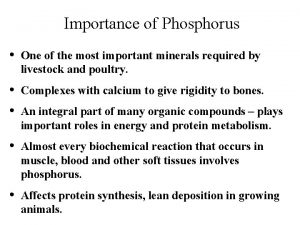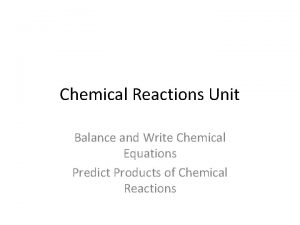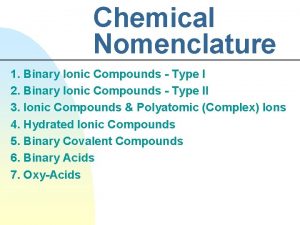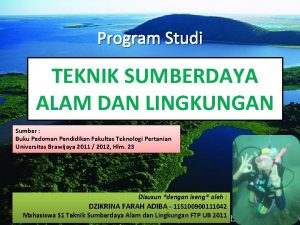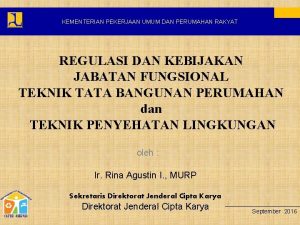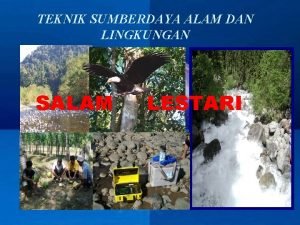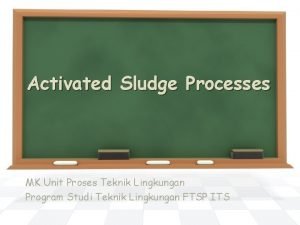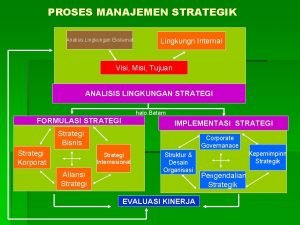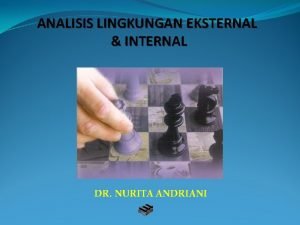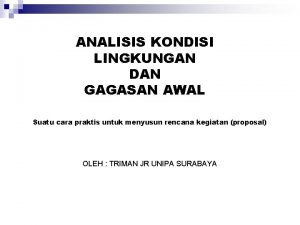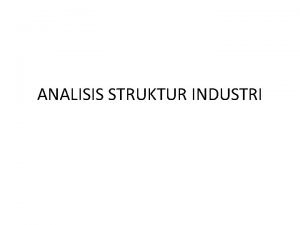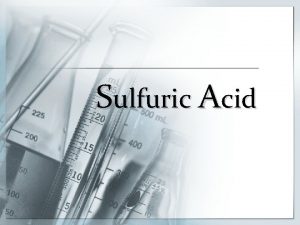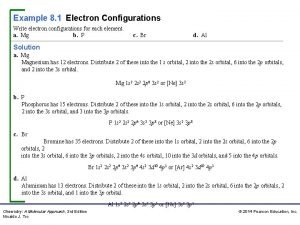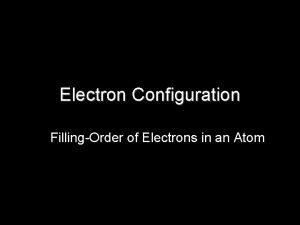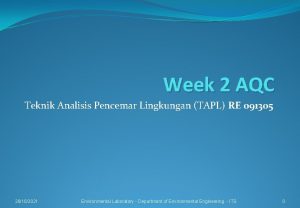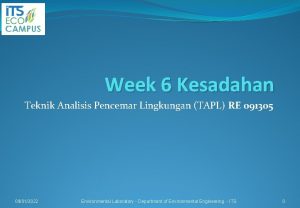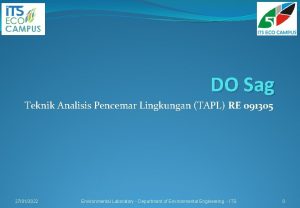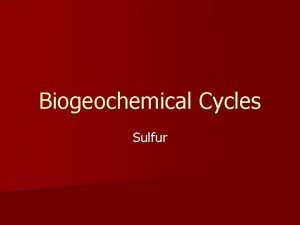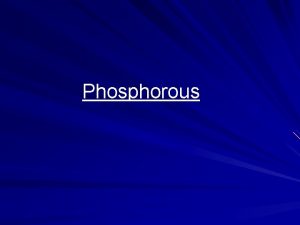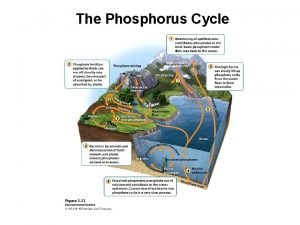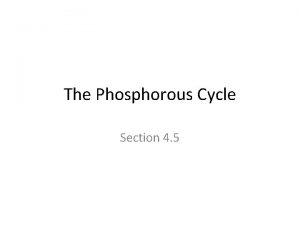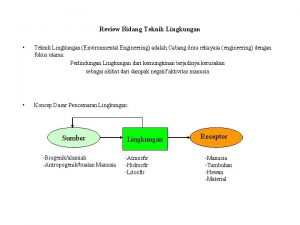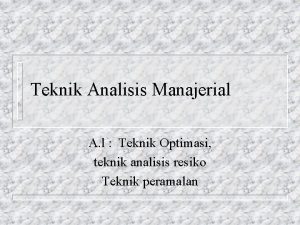Nitrogen Phosphorous Sulfur Teknik Analisis Pencemar Lingkungan Nitrogen




















- Slides: 20

Nitrogen, Phosphorous, Sulfur Teknik Analisis Pencemar Lingkungan

Nitrogen (N 2) Nitrogen occurs in 4 forms in environmental technology: organic nitrogen, ammonia nitrogen, nitrite nitrogen and nitrate nitrogen. Nitrogen is a basic nutrient that is essential to the growth of plants. Nitrification is the process in which nitrogen in the form of ammonia is converted to nitrate nitrogen. Eutrophication = NO 3 , Growth of algae , Water quality NO 3 can enter the groundwater from chemical fertilizers used in agriculture areas. Excessive NO 3 concentrations in drinking water Blue baby/ Methemoglobinemia

Phosphorus (P) Essential nutrient for the growth of algae and the eutrophication of lakes. Its presence in drinking water has little effect on health. Enter water from sewage or from agricultural runoff containing fertilizer and animal waste. 3 - Phosphate (PO 4 ) – inorganic form of phosphorus; used in detergents in the past.

Sulfates (SO 2 -4) Occur in natural waters and in waste water. High concentrations in drinking water causes objectionable tastes, but there is no significant danger to public health. Sulfates in sewage – offensive odours from hydrogen sulfide gas (H 2 S), with its characteristic rotten-egg odour.

Nitrogen: essential to growth of prostita and plants; too little N will inhibit biological treatment, too much can cause O 2 demand excessive algae growth in receiving stream Total Kjeldahl Nitrogen = Organic N + Ammonia N : Nitrite N Nitrate N toxic to fish O 2 demand Eutrophication : stimulates algal & aquatic growth

Phosphorus : essential to growth of microorganisms; necessary nutrient for biological treatment; too much can cause eutrophication Sulfur: required in synthesis of proteins; reduced to H 2 S under anaerobic conditions. (in sewers)

Role of microorganisms: • convert colloidal and dissolved carbonaceous organic matter into various gases and into cell tissue • specific gravity of cell tissue is slightly greater than water ~ removed by gravity settling. Nutritional Requirements of Microorganisms a. b. c. Source of carbon - for growth and synthesis of new cellular material Source of energy – for growth and maintenance Electron acceptor

Types of Systems Aerobic: m/o requires oxygen (aerobic heterotrophs: primary significance in biological treatment of municipal wastewaters) Anaerobic: absence of molecular oxygen Facultative: aerobic microorganisms but can adapt to anaerobic environment Anoxic: absence of molecular oxygen, NO 3 - used as terminal electron acceptor in respiration. NO 3 N 2 denitrification

Classification of microorganisms according to nutritional requirements of microbes 1. Heterotrophs: Source of Carbon: Organic Carbon (BOD, COD, TOC) Source of Energy: Oxidation-Reduction reaction of organic matter Electron-Acceptor: a. Molecular O 2 (aerobic) b. Organic or inorganic substance (anaerobic) Anoxic: NO 3 N 2 Anaerobic: SO 4 H 2 S CO 2 CH 4 c. Facultative

Classification of microorganisms according to nutritional requirements of microbes (cntd…) 2. Autotrophs: Source of Carbon: Inorganic carbon sources (CO 2, HCO 3 -) Source of Energy: a. Sunlight (photosynthesis) b. Oxidation reduction reaction involving inorganic substances NH 3 NO 3 S SO 4 H H 2 O c. Chemosynthetic Autotrophic bacteria: bacteria responsible for nitrification: NH 3 denitrification: nitrosomonas NO 3 - NO 2 - nitrobacter N 2 NO 3 -

TKN


Stochiometry 13

Decomposition organic matter § Aerobic process 14

Decomposition organic matter § Anaerobic process 15

Photosynthesis § Photosynthesis 16

Photosynthesis § Photosynthesis 17

Nitrification § The two step oxidation of ammonia to nitrate: 18

Do Sag

Do Sag
 The importance of phosphorus
The importance of phosphorus Phosphorous oxide formula
Phosphorous oxide formula Binary acid examples
Binary acid examples Pengertian daya dukung lingkungan
Pengertian daya dukung lingkungan Teknik sumber daya alam dan lingkungan
Teknik sumber daya alam dan lingkungan Jenis jabatan fungsional pupr
Jenis jabatan fungsional pupr Teknik sumberdaya alam dan lingkungan
Teknik sumberdaya alam dan lingkungan Asep sofyan
Asep sofyan Unit proses teknik lingkungan
Unit proses teknik lingkungan Analisis lingkungan eksternal manajemen strategik
Analisis lingkungan eksternal manajemen strategik Analisis eksternal
Analisis eksternal Apa itu analisis kondisi lingkungan
Apa itu analisis kondisi lingkungan Keindahan
Keindahan Prinsip dasar analisis kualitas lingkungan
Prinsip dasar analisis kualitas lingkungan Analisis lingkungan eksternal perusahaan
Analisis lingkungan eksternal perusahaan Analisis mengenai dampak lingkungan bertujuan untuk
Analisis mengenai dampak lingkungan bertujuan untuk Manfaat analisis kualitas lingkungan
Manfaat analisis kualitas lingkungan Analisis lingkungan industri
Analisis lingkungan industri Sulfur extraction
Sulfur extraction Orbital box diagram for sulfur
Orbital box diagram for sulfur Electron configuration scale
Electron configuration scale
